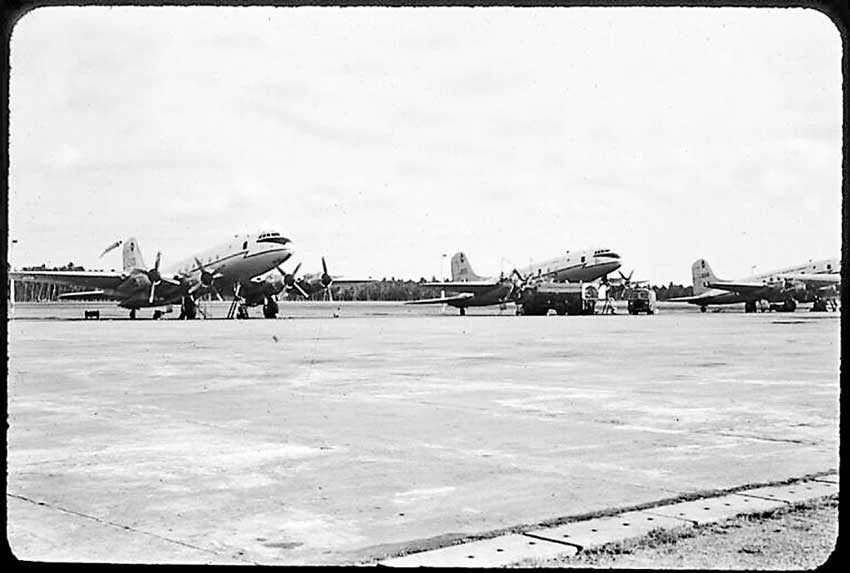Friday Jan 16, 2026
Friday Jan 16, 2026
Saturday, 9 February 2019 00:00 - - {{hitsCtrl.values.hits}}
.
Katunayake Air Force Base in the early days
The Bandaranaike Government had announced a policy of nonalignment in terms of foreign and defence policy, which meant that there was not going to be any alignment with power-blocs.
When Ceylon gained Independence in February 1948, Defence Agreements had been signed with the British government. It was felt that these agreements were contrary to the new policy of nonalignment. This led to discussions being held for a peaceful transfer of the Trincomalee naval base and the Katunayake air force base.
The handover of the Trincomalee base took place on 15 October 1957. Prime Minister Bandaranaike was present at the significant event. The acting British High Commissioner, T.L. Crosthwaite represented the British Government. While a special rain was arranged for VIPs and MPs to come, we drove to Trincomalee well ahead of the time of the transfer. I went with senior Daily News reporter Dalton de Silva who later joined the Defence Ministry as press officer, and photographer Wally Perera.
Speaking about the significance of the event, the Prime Minister said that the occasion marked the removal of a remnant of colonialism. He hailed it as “one more step towards full freedom”.
Trincomalee was a strategic military base occupied by the Portuguese, Dutch, French and the British who found it a convenient spot for their expansion in this part of the world. During World War II (1939-45) Royal Navy ships were anchored in Trincomalee. The Japanese attacked the Trincomalee dockyard during the Easter Sunday raid on 9 April 1942. After the handover Trinco became the base of the Royal Ceylon Navy (created in December 1950 – name changed to Sri Lanka Navy after the country became a Republic).
The Royal Air Force (RAF) base at Katunayake set up by the British in mid 1940s was handed over on 1 November 1957 – two weeks after the handover of Trincomalee.
Calling it another landmark in the history of the country, the Prime Minister said: “It is all a good sign that these things can be done by friendly arrangement and agreement, and in an atmosphere of dignity.”
Almost adjacent to the Bandaranaike Katunayake International Airport, the Sri Lanka Air Force base was attacked by the LTTE on 24 July 2001.

Trincomalee
Colleagues
Incidentally, glancing through the photograph of the band of journalists with Zhou Enlai published in this column last week, I spotted Lakshman Ratnapala, then a reporter of the  ‘Lankadeepa’. We used to meet often on assignments and became friends.
‘Lankadeepa’. We used to meet often on assignments and became friends.
A few years later he joined the tourism sector and went places ending up as President and CEO of the Pacific Asia Travel Association (PATA). Just as much as Lakshman R began as a journalist and branched out into other areas, there were several who made the ‘Dinamina’ their starting point and moved out after a few years. They were all university products.
At the time I joined the Dinamina, there were a few who had come after finishing their degree in the Colombo University. Looking back they were all arts graduates. S.G. Samarasinghe later joined the administrative service and ended up as Head of the Rubber Control Department. M.H. Gunatilleka, a contemporary of mine at Ananda and Peradeniya University who was a keen student of puppetry, joined the Vidyalanakara (later Kelaniya) University staff and rose to be Professor. Wimal Dissanayake and Shelton Gunaratne spent some time in the news desk left and ended up as Professors in Mass Communication in US universities.
There were others who stayed on. In the features desk were Sisil Illangakoon, Features Editor, Hema Gunawardena (she joined Wijeya Newspapers after the nationalisation of Lake House) and B.A. Siriwardena (‘Sira’ as everyone called him) who joined the ‘Aththa’ in 1965 and later became its Editor. A brilliant writer, his hard-hitting editorials are still being talked about by those who were ardent readers of the paper from mid-1960s onwards.
More to follow.